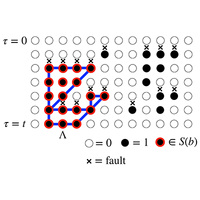定义开放量子系统的稳定相位
IF 11.6
1区 物理与天体物理
Q1 PHYSICS, MULTIDISCIPLINARY
引用次数: 0
摘要
动力学过程的稳态可以表现出稳定的非三维阶段,也可以作为容错的经典或量子存储器。对于马尔可夫量子(经典)动力学,这些稳态是产生动力学的非ermitian 算子(即量子通道(马尔可夫链))的极值特征向量。然而,由于这些算子是非全息的,它们的频谱对于动态弛豫时标或对抗扰动的稳定性来说是不可靠的指导。我们提出了另一种稳态处于稳定阶段的动力学标准,并将其命名为均匀性:从形式上看,我们的标准相当于要求在足够小的局部动力学扰动下,未扰动稳态和扰动稳态通过有限时间耗散演化相互关联。我们证明,这一标准意味着相的任何合理定义所要求的许多特性。我们证明了在一个典型的经典蜂窝自动机中满足了均匀性,并提供了数值证据,证明间隙决定了同一相位中邻近稳态之间的松弛率,我们猜想只要满足了均匀性,这种情况一般都会成立。我们进一步猜想了通道表现出均匀性并因此表现出稳定性的一些充分条件。本文章由计算机程序翻译,如有差异,请以英文原文为准。

Defining Stable Phases of Open Quantum Systems
The steady states of dynamical processes can exhibit stable nontrivial phases, which can also serve as fault-tolerant classical or quantum memories. For Markovian quantum (classical) dynamics, these steady states are extremal eigenvectors of the non-Hermitian operators that generate the dynamics, i.e., quantum channels (Markov chains). However, since these operators are non-Hermitian, their spectra are an unreliable guide to dynamical relaxation timescales or to stability against perturbations. We propose an alternative dynamical criterion for a steady state to be in a stable phase, which we name uniformity: Informally, our criterion amounts to requiring that, under sufficiently small local perturbations of the dynamics, the unperturbed and perturbed steady states are related to one another by a finite-time dissipative evolution. We show that this criterion implies many of the properties one would want from any reasonable definition of a phase. We prove that uniformity is satisfied in a canonical classical cellular automaton, and we provide numerical evidence that the gap determines the relaxation rate between nearby steady states in the same phase, a situation we conjecture holds generically whenever uniformity is satisfied. We further conjecture some sufficient conditions for a channel to exhibit uniformity and therefore stability.
求助全文
通过发布文献求助,成功后即可免费获取论文全文。
去求助
来源期刊

Physical Review X
PHYSICS, MULTIDISCIPLINARY-
CiteScore
24.60
自引率
1.60%
发文量
197
审稿时长
3 months
期刊介绍:
Physical Review X (PRX) stands as an exclusively online, fully open-access journal, emphasizing innovation, quality, and enduring impact in the scientific content it disseminates. Devoted to showcasing a curated selection of papers from pure, applied, and interdisciplinary physics, PRX aims to feature work with the potential to shape current and future research while leaving a lasting and profound impact in their respective fields. Encompassing the entire spectrum of physics subject areas, PRX places a special focus on groundbreaking interdisciplinary research with broad-reaching influence.
 求助内容:
求助内容: 应助结果提醒方式:
应助结果提醒方式:


